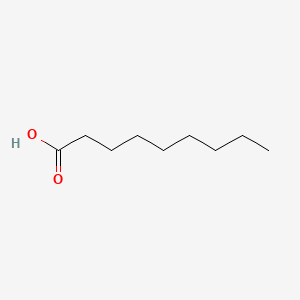| MeSH term | MeSH ID | Detail |
|---|---|---|
| Dermatitis, Contact | D003877 | 59 associated lipids |
| Facial Dermatoses | D005148 | 7 associated lipids |
| Hypersensitivity | D006967 | 22 associated lipids |
| Arteriosclerosis | D001161 | 86 associated lipids |
| Seizures | D012640 | 87 associated lipids |
| Dermatitis, Allergic Contact | D017449 | 20 associated lipids |
| Riboflavin Deficiency | D012257 | 10 associated lipids |
| Lichen Planus | D008010 | 3 associated lipids |
| Keratosis | D007642 | 9 associated lipids |
| Tick Infestations | D013984 | 4 associated lipids |
NONANOIC ACID
NONANOIC ACID is a lipid of Fatty Acyls (FA) class. Nonanoic acid is associated with abnormalities such as megalocytosis, Hypos, Renal tubular disorder, Respiratory Distress Syndrome, Adult and Little's Disease. The involved functions are known as Gene Expression, Signal Transduction, Regulation, Cell Cycle and Force. Nonanoic acid often locates in Membrane, Protoplasm, Body tissue, Extracellular and Cell membrane. The associated genes with NONANOIC ACID are cysteinylglycine, glycylsarcosine, arginine methyl ester, GLI3 gene and ADRBK1 gene. The related lipids are 1-octen-3-ol, Butyric Acids, palmitoleic acid, pentadecanoic acid and stearic acid.
Cross Reference
Introduction
To understand associated biological information of NONANOIC ACID, we collected biological information of abnormalities, associated pathways, cellular/molecular locations, biological functions, related genes/proteins, lipids and common seen animal/experimental models with organized paragraphs from literatures.
What diseases are associated with NONANOIC ACID?
NONANOIC ACID is suspected in megalocytosis, Hypos, Renal tubular disorder, Respiratory Distress Syndrome, Adult, Little's Disease and other diseases in descending order of the highest number of associated sentences.
Related references are mostly published in these journals:
- Am. J. Physiol. Heart Circ. Physiol. (1)
- Am. J. Physiol. Lung Cell Mol. Physiol. (1)
- Am. J. Physiol. Renal Physiol. (1)
- Others (1)
| Disease | Cross reference | Weighted score | Related literature |
|---|
Possible diseases from mapped MeSH terms on references
We collected disease MeSH terms mapped to the references associated with NONANOIC ACID
PubChem Associated disorders and diseases
What pathways are associated with NONANOIC ACID
There are no associated biomedical information in the current reference collection.
PubChem Biomolecular Interactions and Pathways
Link to PubChem Biomolecular Interactions and PathwaysWhat cellular locations are associated with NONANOIC ACID?
Visualization in cellular structure
Associated locations are in red color. Not associated locations are in black.
Related references are published most in these journals:
- Am. J. Physiol. Heart Circ. Physiol. (4)
- Prostaglandins Leukot. Essent. Fatty Acids (1)
- Am. J. Physiol. Lung Cell Mol. Physiol. (1)
- Others (6)
| Location | Cross reference | Weighted score | Related literatures |
|---|
What functions are associated with NONANOIC ACID?
Related references are published most in these journals:
| Function | Cross reference | Weighted score | Related literatures |
|---|
What lipids are associated with NONANOIC ACID?
Related references are published most in these journals:
| Lipid concept | Cross reference | Weighted score | Related literatures |
|---|
What genes are associated with NONANOIC ACID?
Related references are published most in these journals:
- Am. J. Physiol. Heart Circ. Physiol. (2)
- Acta Trop. (1)
- Am. J. Physiol. Lung Cell Mol. Physiol. (1)
- Others (3)
| Gene | Cross reference | Weighted score | Related literatures |
|---|
What common seen animal models are associated with NONANOIC ACID?
There are no associated biomedical information in the current reference collection.
NCBI Entrez Crosslinks
All references with NONANOIC ACID
Download all related citations| Authors | Title | Published | Journal | PubMed Link |
|---|---|---|---|---|
| Sato J et al. | Dietary antioxidants preserve endothelium dependent vasorelaxation in overfed rats. | 2002 | Atherosclerosis | pmid:11888515 |
| Siegert A et al. | Nitric oxide of human colorectal adenocarcinoma cell lines promotes tumour cell invasion. | 2002 | Br. J. Cancer | pmid:11953890 |
| Abi-Gerges N et al. | NO donors potentiate the beta-adrenergic stimulation of I(Ca,L) and the muscarinic activation of I(K,ACh) in rat cardiac myocytes. | 2002 | J. Physiol. (Lond.) | pmid:11956332 |
| Boxman IL et al. | Proteomic analysis of skin irritation reveals the induction of HSP27 by sodium lauryl sulphate in human skin. | 2002 | Br. J. Dermatol. | pmid:12000373 |
| Fullerton A et al. | Skin irritation typing and grading based on laser Doppler perfusion imaging. | 2002 | Skin Res Technol | pmid:12005117 |
| Strecker T et al. | Increase in meningeal blood flow by nitric oxide--interaction with calcitonin gene-related peptide receptor and prostaglandin synthesis inhibition. | 2002 | Cephalalgia | pmid:12047464 |
| Lam CF et al. | The effects of inhalation of a novel nitric oxide donor, DETA/NO, in a patient with severe hypoxaemia due to acute respiratory distress syndrome. | 2002 | Anaesth Intensive Care | pmid:12180587 |
| Lakshmi VM et al. | Nitrosation and nitration of 2-amino-3-methylimidazo[4,5-f]quinoline by reactive nitrogen oxygen species. | 2002 | Chem. Res. Toxicol. | pmid:12184790 |
| Keynes RG et al. | Superoxide-dependent consumption of nitric oxide in biological media may confound in vitro experiments. | 2003 | Biochem. J. | pmid:12366375 |
| Nakamura M et al. | Nitration and chlorination of folic acid by peroxynitrite and hypochlorous acid, and the selective binding of 10-nitro-folate to folate receptor beta. | 2002 | Biochem. Biophys. Res. Commun. | pmid:12372420 |
